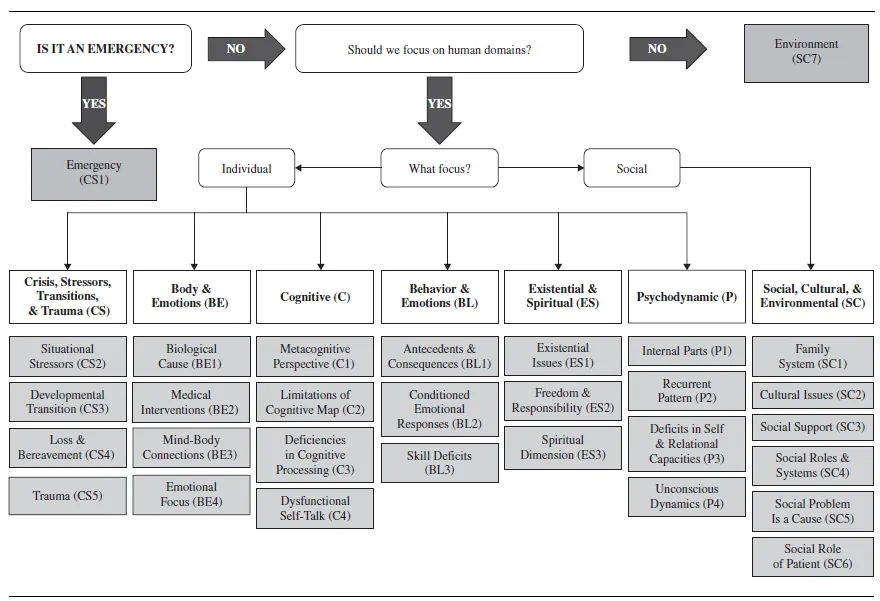
Clinical Case Formulations
Matching the Integrative Treatment Plan to the Client
- English
- ePUB (mobile friendly)
- Available on iOS & Android
Clinical Case Formulations
Matching the Integrative Treatment Plan to the Client
About this book
Praise for Clinical Case Formulations
Matching the Integrative Treatment Plan to the Client, Second Edition
"[Barbara Ingram has put] a career into the development of this book and it is wonderful! My students love that it was written with them in mind and they love the statements designed to reduce anxiety and normalize the learning process. This is an excellent book!"—Amy M. Rees-Turyn, PhD Associate Professor of Counseling Psychology, Lewis & Clark College
A step-by-step model for individualized case conceptualization
Fully revised and updated, the second edition of Clinical Case Formulations provides step-by-step tools and insightful guidance for moving from first contact with a client to the development of an effective, personalized treatment plan. Addressing the essential question every therapist faces— How do I create a treatment plan that is the best match for my client? —this unique resource provides a systematic and thoughtful method for integrating ideas, skills, and techniques from different theoretical approaches. It combines empirical research and clinical experience to create a case formulation that is tailor-made for the client.
This comprehensive resource offers two tools to guide case formulations: a problem-oriented framework, with a list of 28 standards for evaluating its application, and a set of 30 core clinical hypotheses derived from the knowledge bases of psychology, psychiatry, counseling, and social work professions.
The new edition includes:
-
Hypotheses on Emotional Focus, Trauma, and Metacognitive Perspective
-
More detailed attention given to empirically supported therapies such as Dialectical Behavior Therapy (DBT) and Acceptance and Commitment Therapy (ACT)
-
Discussion on the importance of bringing cultural competence to case formulation tasks with every client
-
Skill-building activities throughout the text
Offering a thorough framework to help clients experience effective clinical service, practitioners will learn to conceptualize clients' needs in ways that lead to strong and individualized treatment plans, as well as advice and guidance on what to do when selected interventions fail to produce the expected benefits.
Frequently asked questions
- Essential is ideal for learners and professionals who enjoy exploring a wide range of subjects. Access the Essential Library with 800,000+ trusted titles and best-sellers across business, personal growth, and the humanities. Includes unlimited reading time and Standard Read Aloud voice.
- Complete: Perfect for advanced learners and researchers needing full, unrestricted access. Unlock 1.4M+ books across hundreds of subjects, including academic and specialized titles. The Complete Plan also includes advanced features like Premium Read Aloud and Research Assistant.
Please note we cannot support devices running on iOS 13 and Android 7 or earlier. Learn more about using the app.
Information
PART ONE
CASE FORMULATION SKILLS
- Gather data about each unique client.
- Define the client’s problems, writing clear, specific, jargon-free titles.
- Specify outcome goals that are realistic and attainable.
- Apply relevant clinical hypotheses to conceptualize problems.
- Design treatment plans that follow logically from your conceptualization and focus on achieving goals.
Chapter 1
A FRAMEWORK FOR CLINICAL CASE FORMULATIONS

Overview
- Gathering data (Chapter 2)
- Defining problems (Chapter 3)
- Specifying outcome goals, the desired change in the client’s functioning (Chapter 4)
- Organizing and presenting the database (Chapter 5)
- Creating the formulation by applying core clinical hypotheses (Chapter 6)
- Writing a treatment plan and monitoring progress (Chapter 7)
- 1. Crisis, Stressful Situations, Transitions, and Trauma (CS: Chapter 8)
- 2. Body and Emotions (BE: Chapter 9)
- 3. Cognitive Models (C: Chapter 10)
- 4. Behavioral and Learning Models (BL: Chapter 11)
- 5. Existential and Spiritual Models (ES: Chapter 12)
- 6. Psychodynamic Models ...
Table of contents
- Cover
- Table of Contents
- Title
- Copyright
- Dedication
- List of Tables
- Preface
- Acknowledgments
- PART ONE: CASE FORMULATION SKILLS
- PART TWO: THIRTY CORE CLINICAL HYPOTHESES
- References
- Appendix I: USEFUL CHARTS
- Appendix II: USEFUL FORMS
- Appendix III: CASE MATERIAL FOR PRACTICE
- Appendix IV: ANSWERS AND SAMPLES FOR ACTIVITIES
- Author Index
- Subject Index
- End User License Agreement